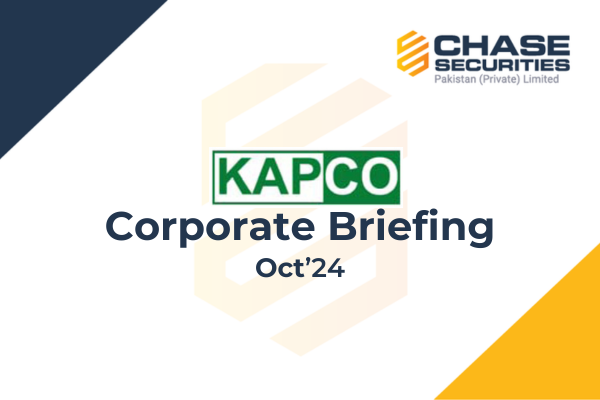In FY24, KAPCO reported a net profit of PKR 4.3 billion (EPS: PKR 4.90), an increase from PKR 3.96 billion (EPS: PKR 4.50) in the previous year.
This growth in profitability was primarily driven by investments in mutual funds, a significant reduction in taxes, and the rationalization of expenses.
Management disclosed that the extended general license expired in September 2024. However, the Company has applied for a seven-year extension to support further expansion.
Additionally, NEPRA approved the Power Acquisition Plan for 2023-2027, which incorporates KAPCO’s 500 MW plant to address system constraints. NEPRA also extended the PPA following NTDC’s notification to CPPA-G to maintain a stable power supply to MEPCO. KAPCO has allocated approximately Rs. 47 billion to Mutual Funds as part of its strategy to diversify into greenfield and brownfield projects. In FY24, the Company submitted a bid to acquire equity stakes in Tenaga Generasi Limited, which operates a 49.5 MW wind power project.
Furthermore, KAPCO conducted a detailed technical and financial evaluation for a 600 MW Solar Project announced by PPIB. However, no bids were placed due to the unavailability of foreign funding.
Due diligence is currently underway for various wind, hydel, and thermal projects. In September 2024, KAPCO placed bids for two greenfield solar projects: the 120 MW Halkani project and the 150 MW Metha Ghar project.
Management indicated that an excess capacity of 1,100 MW will be utilized in two phases. In Phase I, KAPCO plans to dispose of its least efficient machines, while in Phase II, the management aims to participate in the anticipated CTBCM within the next 1 to 1.5 years, focusing on more efficient machines.
KAPCO has applied for a revised tariff and expects approval within a few months. Management attributed the delay to recent IPP issues in the country. Additionally, KAPCO is currently exporting furnace oil due to the non-renewal of its PPA. Operating profit decreased to PKR 9.32 billion in FY24 compared to PKR 13.07 billion in the SPLY.
Other income was reported at PKR 14.63 billion in FY24, down from PKR 15.83 billion in the previous year. Since 1996, KAPCO has paid PKR 162 billion in dividends, with PKR 126 billion distributed since its listing in 2015. The current assets include PIB/Sukuk investments of PKR 47.4 billion, trade receivables of PKR 10.9 billion, fuel inventory of PKR 13.8 billion, advances, deposits, and taxes of PKR 4.5 billion, and cash of PKR 2.7 billion. Total current assets for FY24 are reported at PKR 79.3 billion, down from PKR 98.9 billion in the same period last year.
Current liabilities stand at PKR 18.2 billion in FY24 compared to PKR 32.8 billion in the prior year. The breakdown of current liabilities consists of PKR 9.9 billion in bank finances, PKR 7.1 billion in trade payables, and PKR 1.2 billion in dividends. Going forward, KAPCO has no plans for liquidation.
The Company intends to pay reasonable dividends to shareholders while investing in two projects, expecting a double-digit return on investment from these new initiatives.
Additionally, KAPCO plans to install a 1-2 MW solar power plant at its facility for auxiliary consumption and anticipates generating revenue from the 500MW plant before summer 2025, contingent upon the approval of a take-and-pay agreement by December 2024.

Important Disclosures
Disclaimer:
This report has been prepared by Chase Securities Pakistan (Private) Limited and is provided for
information purposes only. Under no circumstances, this is to be used or considered as an offer to sell or
solicitation or any offer to buy. While reasonable care has been taken to ensure that the information
contained in this report is not untrue or misleading at the time of its publication, Chase Securities makes
no representation as to its accuracy or completeness and it should not be relied upon as such. From
time to time, Chase Securities and/or any of its officers or directors may, as permitted by applicable laws,
have a position, or otherwise be interested in any transaction, in any securities directly or indirectly
subject to this report Chase Securities as a firm may have business relationships, including investment
banking relationships with the companies referred to in this report This report is provided only for the
information of professional advisers who are expected to make their own investment decisions without
undue reliance on this report and Chase Securities accepts no responsibility whatsoever for any direct or
indirect consequential loss arising from any use of this report or its contents At the same time, it should
be noted that investments in capital markets are also subject to market risks This report may not be
reproduced, distributed or published by any recipient for any purpose.

